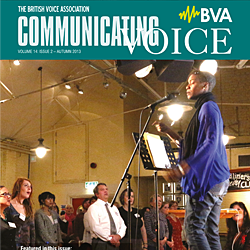About the Association
Archived newsletter articles
Vocal Archives
By Gordon Stewart
In olden days when singing was one of the ways of lifting yourself out of a poor social background - the old equivalent of boxing maybe? - someone obviously knew something about singing. It wasn't enough in Baroque times to have a sharp knife to create a singer; extensive training over a period of years - set as a minimum at seven and in some cases lasting for ten - was vital.
The evidence of what was taught and how is not very precise, but there were books on singing. We know how hard it is to write such books even now, hemmed in as one is by the difficulty of identifying the readership profile and by the problems of agreeing a common language. Nevertheless the great singers and teachers had knowledge, and they wrote or were written about. The singers who lasted a long time, the singers who re-worked their voices, went to teachers who were known for their safe hands. Admittedly, we tend to hear only of the successes, and not the ones that fell by the wayside because they didn't fit into the moulds (the same could well be true today).
It would be good to find out more, to gather an index of it into one identifiable place the writing, the anecdotes, the reports of singers over the years.
There is already some intriguing, and potentially instructive intelligence. Brigitta Bandi, born in the same year as Mozart, left her larynx, reputed to have been of a remarkable size, to the city of Bologna. That in itself tells us something about her. She had begun life as a street-singer in Corsica and progressed to international success (Haydn wrote his Scena di Berenice for her) by virtue of the quality of her voice. She ruined her life by habitual vice, and her career by the fact that she not only never learnt to read music, which is still not uncommon, but even more by an innate lack of musicality, which meant that in da capo arias she was likely to go round and round until stopped The larynx still hasn't been discovered, as far as I know.
Angelica Catalani in the early nineteenth century prompted this review: "Her throat seems endowed (as has been remarked by medical men) with a power of expansion and muscular motion by no means usual, and when she throws out all her voice to the utmost has a volume and strength that are quite surprising." The Queen (Caroline) said she needed cotton wool in her ears when Catalani was singing.
In the past many singers began their careers at the incredibly early ages, and survived. Even allowing for changes in operatic style, not least in dynamics, there were surprises. Henriette Sontag created the role of Euryanthe in Weber's opera - of its nature one of the heavier roles in the repertoire (Jessye Norman has recorded it) - at the age of seventeen. At the age of eighteen, she sang the soprano part in the first performance of Beethoven's ninth symphony, also intrinsically lirico-dramatic, and was still singing (often two Donizetti operas in a day) and singing well, right up to her premature death of cholera at the age of 48. She presumably knew something about singing, even if were only her own.
Mathilde Marchesi trained Nellie Melba, who was a late starter, especially in her day - she was twenty-seven or so when she made her debut. She must have been singing before that, but what she got from Marchesi was enough to keep her going until a very late retirement. There are reports of Marchesi's training methods.
Then there are interesting cases of singers who retrained, or had to save their voices by some radical means (usually lessons), so there was obviously well-founded expertise which could do such things. Jenny Lind, who by the age of twenty-one had already sung Donna Anna in Don Giovanni, Lucia di Lammermoor, and Norma (one of the killer roles), ran into deep trouble. It was Manuel Garcia (son of the original Count in the Barber of Seville, inventor of laryngoscope) who sorted her out. "I never had to explain anything to her twice," he said. He clearly had something to explain. In the novel Daniel Deronda, George Eliot described one of her characters as having a voice which people compared to Jenny Lind: "a moderately powerful soprano", which gives a sophisticated view of how Lind's voice was.
Adophe Nourrit, French tenor of the earlier part of the nineteenth century, friend of Chopin and Liszt (who played for him when he sang Schubert songs), attempted to beef up his voice once it became clear that his sort of singing was being outdistanced by a new strain (not the ideal word!) of tenor who could produce the ut de poitrine - the trumpet-like top C. He re-trained in Italy, finding a voix sombre, but at the cost of the nuances which led George Sand to describe his voice as having "passionate and glowing tone" when he sang Schubert.
[Gilbert Louis Duprez, who was the man who was supposed to have started the big-voiced tenor (he wasn't actually the first), had a small voice at the beginning of his career - they said that if you wanted to hear him you had to sit in the prompt box, but, by means of "the concentration of every resource of will power and physical strength" (his words) he found the power and the strong top C. He described Nourrit as "having the quality of what used to be called haute-contre, and he could sing very high in a mixed register." Duprez's voice, by the age of forty-three, had, he admitted, lost its freshness, brilliance and flexibility, and all that remained was his strength - which apparently he used to great effect.]
On the other hand Marietta Alboni kept her voice until she was seventy, "In my youth I rarely attended rehearsals, and it saved me much wear and tear. Remember this: what comes out of your throat never goes in again. Don't let them work you to death." They say she was a beautiful singer, but a dull one, as you might imagine.
A century later, Caruso and Tetrazzini were persuaded to give lectures on singing.
Caruso, in 1909, said: "Vocal work with closed mouth is… a powerful auxiliary to vocal agility. Many great artists perform their daily vocal exercises with the mouth shut, and I can personally testify to the excellency of this practice. It most certainly strengthens the breath powers and at the same time rests the voice. But one should know how to do it properly.
The evidence of a successful singer is always worth analysis. This is Luisa Tetrazzini, talking about the difficulty of having to sing in the last act of La Traviata lying down (those were the days when many singers believed in standing, preferably centre stage, close to the footlights): "in order to get proper resonance to some of the high notes I have to start them in the head cavity by means, of course, of the apoggio, or breath prop, without which the note would be thin and would have no body to it. The sensation that I have is of a slight pressure of breath striking almost into a direct line into the cavity behind the forehead over the eyes without any obstruction or feeling in the throat at all.
These cases contain information, if we could interpret it, and take it on board. One of the important things about a historical view is the chance to see a singing life as a whole. The success of teaching, of instruction, depends not so much on the effect you can have in an hour (leaving out the extreme cases) but in what happens over a lifetime. Some sort of readily accessible archive information might help.
Gordon Stewart, formerly Head of the Voice Department at the Royal Scottish Academy of Music and Drama, trained as a singer and a pianist at the Royal College of Music, he writes, reviews books on singing, teaches and has an interest in vocal music and the speaking voice.
More archived content online
Disclaimer
Neither the British Voice Association nor the Editor can be held responsible for errors or any consequences arising from the use of information contained in its newsletters (or extracts from its newsletters published online); the views and opinions expressed do not necessarily reflect those of the British Voice Association (BVA) or the Editor, neither does the publication of advertisements constitute any endorsement by the BVA or Editor of any products or services featured.

 Join us Now!
Join us Now! our newsletter
our newsletter free voice care leaflets & information – download here
free voice care leaflets & information – download here Help our work by donating while you shop
Help our work by donating while you shop